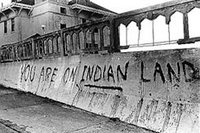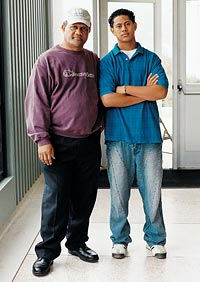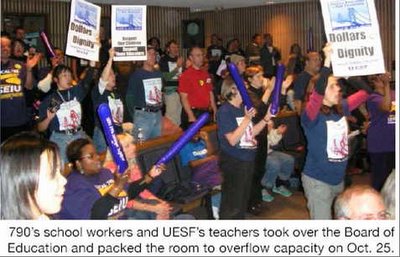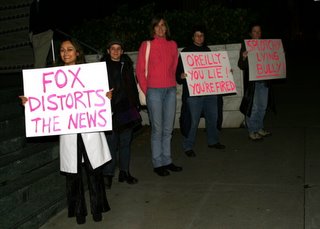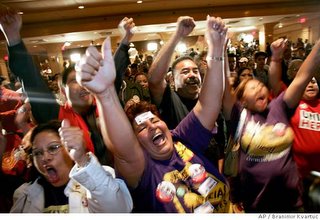 As usual, people's journalist David Bacon provides a useful analysis of the politics behind immigration reform legislation, the rebuilding of New Orleans, and 'divide and conquer' media messages. In his conclusion he helps point us in a more constructive direction of multiracial justice and economic sustainability.
As usual, people's journalist David Bacon provides a useful analysis of the politics behind immigration reform legislation, the rebuilding of New Orleans, and 'divide and conquer' media messages. In his conclusion he helps point us in a more constructive direction of multiracial justice and economic sustainability.DIVIDED WE FALL - By David Bacon
From Colorlines Magazine - [you will have to wait for the full article in the Feb 06 issue]
If Congress' current proposals for immigration reform pass this year or next, will they help the immigrant workers now doing reconstruction on the Gulf Coast? What about the residents hoping to return home - what might these proposals mean for racial divisions already fanned by New Orleans Mayor Ray Nagin and syndicated newspaper columnist Ruben Navarette in the wake of the flood?
Both Nagin and Navarette play on growing insecurity on each side of the migration divide. "How do I ensure that New Orleans is not overrun by Mexican workers?" the Mayor asked in early November. Navarette praised immigrants for "not sitting around and waiting for government to come to the rescue. They're probably living two or three families to a house ... that's how it used to be in this country before the advent of the welfare state." African American politicians, he said, just want to "keep the city mostly Black."
It's not a theoretical problem. The Gulf Coast disaster is having a profound and permanent effect on the area's workers and communities. The racial fault lines of immigration politics threaten to pit Latinos against Blacks, and migrant laborers against community residents hoping to return to their homes. Community organizations, labor and civil rights advocates can all find common ground in a reconstruction plan that puts the needs of people first.
But flood-ravaged Mississippi and Louisiana could also become a window into a different future, in which poor communities with little economic power fight each other over jobs. Even before Hurricane Katrina hit, the unemployment rate among Gulf residents was among the nation's highest. ...In New Orleans, Blacks, concentrated in public-sector jobs and already reeling from the storm and flood, were hit again by massive layoffs. With no sure job waiting for them, few families had the resources to simply go back and take a chance on finding new employment. The Bureau of Labor Statistics found in October that 500,000 of the 800,000 people evacuated had yet to return home.
....
In the hurricane-affected areas, fears generated by competition are already apparent. Politicians like Nagin, using racial fears to win votes, and columnists like Navarette, seeking to incite racial hysteria among readers, both see gains to be made from increased division. Yet as immigration changes the demographics of the South, its communities have a good record of reaching across racial lines."Every immigrant rights bill in Mississippi has been introduced by African American legislators," Chandler says. In the state's poultry and meatpacking plants, longtime Black workers and a new wave of immigrants have found themselves on the same side in union organizing efforts. Hurricane relief is a key test of those bonds, and the desire to achieve common ground.
This year the Congressional Black Caucus made two important contributions to this effort. The CBC-sponsored HR 4197 addresses hurricane recovery and poverty, authorizing funds for housing and new Section 8 vouchers, for increased health care, and for extended unemployment and temporary assistance to needy families. It provides money to help returning residents rebuild their homes or seek new ones,
and for schools to help relocated students. The bill reinstates Davis Bacon wage requirements, creates apprenticeship programs to develop good jobs, and requires the President to present a plan for eradicating poverty.For Pitts, this moves in the right direction. "You have to assure there's a floor under wages," he suggests, "Both immigrants and African Americans need this. To ensure people can return, the government has to recognize the need for two kinds of income-wages from decent jobs, and money to cover the cost of relocation.
Immigrants need a living wage too, as well as the right to organize and the ability to move freely, so they're not tied to an employer or contractor." The CBC also supported another bill this spring, by Houston Congresswoman Sheila Jackson Lee. The Save America Comprehensive Immigration Act of 2005, HR 2092, provides a way for currently undocumented workers to gain permanent resident status, and enforces migrants' rights in the workplace. Unlike every other immigration proposal in Congress, it has no guest worker program, and doesn't call for greater enforcement of employer sanctions. It will take the fees paid by people applying for legal status, and use them to provide job creation and training programs in communities with high levels of unemployment. For community and labor activists who see Kennedy/McCain and similar proposals as dangerous, Jackson Lee's bill provides at least a partial program for progressive immigration reform.
The key to finding common ground is fighting for jobs for everyone. Whether Black, white, Asian or Latino, native-born or immigrant-no one can live without work. Yet this basis for an alliance of mutual interest has largely fallen off the liberal agenda. Even unions, the bastion of support for the Humphrey-Hawkins Full Employment Act, a 1970s proposal that the federal government provide jobs to eradicate unemployment, pay only lip service to the idea today. In the Democratic Party, free market ideologues ridicule the idea that the government should guarantee employment, as it did in the New Deal programs of the 1930s. Instead, both parties propose to pile guest worker programs, and increased enforcement of employer sanctions, on top of job competition. This is an explosive mixture in which no one has the right to a job, and everyone shares only increased insecurity.
Unemployment and racism in the U.S. economic system pit communities of color against each other, and against working-class white communities. Competition produces lower labor costs and higher
profits. It's no accident that the guestworker programs in Congress are pushed by the Essential Worker Immigration Coalition, which includes 38 of the country's largest industrial and business associations.Racial division is a powerful political weapon as well, helping to maintain a conservative Republican majority in Congress and the White House. By the same token, for working communities, overcoming racial division creates new possibilities for winning political power.
In the early 1980s a Black-Latino alliance defeated the Chicago political machine and elected Harold Washington mayor. In the spring of 2005 the same strategy elected Antonio Villaraigosa mayor of Los Angeles, where division between Blacks and Latinos was used to keep conservatives in power for decades. The rebuilding of Biloxi, Gulfport and New Orleans can forge a similar political coalition on the Gulf Coast too. But to accomplish that, working class communities will have to reject the use of immigration as a new dividing line to keep them apart.

